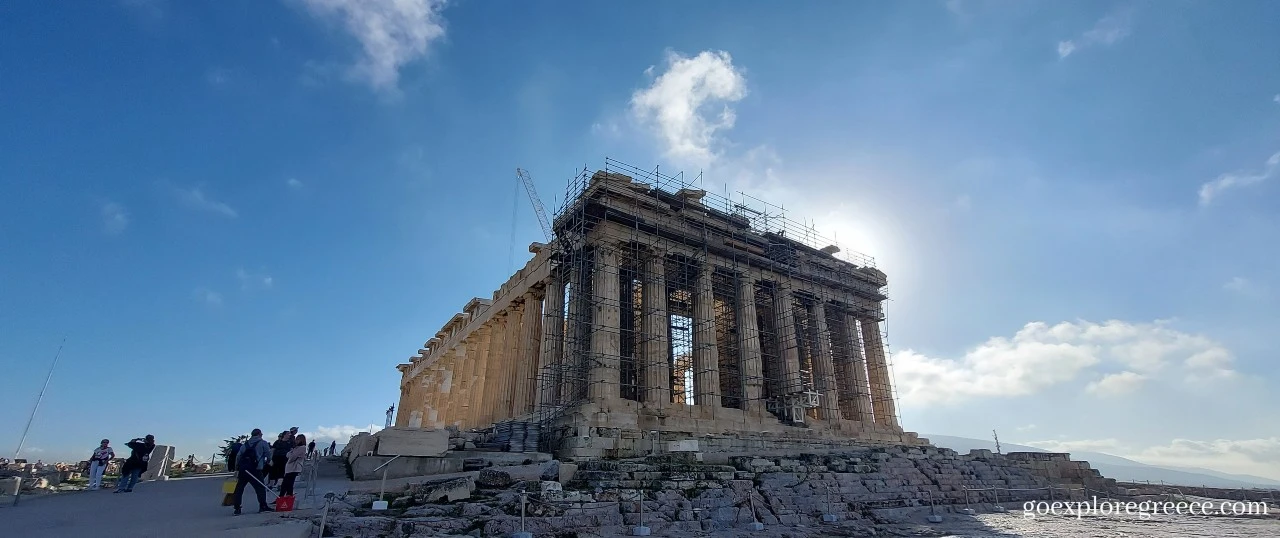Did you know that Athens has the best collection of ancient sites in the world? You won’t have time to visit them all, so deciding which ancient sites to visit in Athens is essential.
From ancient ruins, centuries-old trees or hidden gems waiting just around the next corner, take it from me; there’s always something new to see.
Obviously, the Parthenon on the Acropolis is top of almost everyone’s list, but there are many more.
In this blog, I will provide you with an overview of the best ancient sites to visit in Athens.
What are the Best Ancient Sites to Visit in Athens?
The following are my choice of the best ancient sites to visit in Athens.
1. The Parthenon
Best overall for the feeling of history and for the views over Athens.
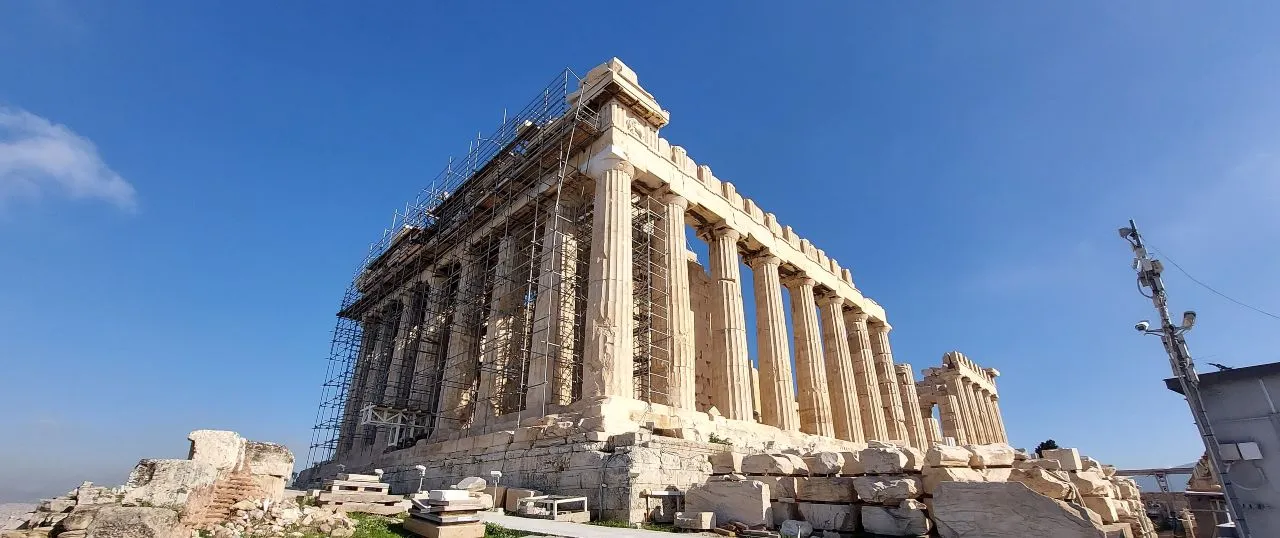
About the Parthenon
Number one on the list of the best ancient sites to visit in Athens is the Parthenon. It is the most popular thing to see in Athens with around two million visiting every year.
Perhaps the most famous building in the world, the Parthenon, is the epitome of ancient Greece. Built as an expression of ancient Athen’s glory, it remains the city’s emblem to this day.
Situated on top of the Acropolis, it is dedicated to the goddess Athena, whom the people of Athens worshipped and considered their patroness.
Construction of the temple began in 447 BC and was completed in 438 BC, although decoration of the building continued until 432 BC.
For a time, it served as a treasury, and around 590 AD was converted into a Christian church dedicated to the Virgin Mary. After the Ottoman conquest, the Parthenon was turned into a mosque in the early 1460s.
On September 26th 1687, an Ottoman ammunition dump inside the building was ignited by Venetian bombardment during a siege of the Acropolis. The resulting explosion severely damaged the Parthenon and its sculptures.
From 1800 to 1803, The 7th Earl of Elgin removed some of the surviving sculptures, now known as the Elgin Marbles.
The Parthenon itself replaced an older temple of Athena, which historians call the Pre-Parthenon or Older Parthenon, that was demolished in the Persian invasion of 480 BC.
The Parthenon is regarded as an enduring symbol of Ancient Greece, democracy and Western civilization and one of the world’s most significant cultural monuments. Like most Greek temples, the Parthenon served a practical purpose as the city treasury. Its decorative sculptures are considered some of the high points of Greek art. These reasons are good enough to suggest the Parthenon is one of the best ancient sites to visit in Athens.
To the Athenians who built it, the Parthenon, and other Periclean monuments of the Acropolis, were seen fundamentally as a celebration of Hellenic victory over the Persian invaders and as a thanksgiving to the gods for that victory.
Since 1975, numerous large-scale restoration projects have been undertaken to ensure the structural stability of the temple.
Best Things to do and See
- Admire the perfect proportions of the temple – it was designed to represent the ideal human form.
- Take in the panoramic views of Athens from the Parthenon’s summit.
- Learn about the history of the temple and its construction at the on-site museum.
- See the impressive remains of the Parthenon’s roof, which was destroyed by an earthquake in 1801.
- The frieze on the east side of the Parthenon, above the main entrance, depicts the mythical battle between the Olympian gods and the Giants.
- The frieze on the west side the mythical battle of the Athenians against the Amazons.
- The frieze on the south side shows the battle of the legend people of Thessaly aided by Theseus against the half-man, half-horse (Centaurs).
- The mythological figures of the metopes of the East, North, and West sides of the Parthenon had been deliberately mutilated in the late roman empire.
Best Places for Photos, Videos, and the Perfect Instagram
- Get there early – the early morning light is perfect for photography.
- Stay away from the crowds – try to find a spot where you can take photos without people in them.
- The front of the Parthenon, with the cityscape in the background.
- The side of the Parthenon, with the steps leading up to it.
- The back of the Parthenon, with the Acropolis in the background.
- The top of the Parthenon, with a bird’s eye view of Athens.
- The bottom of the Parthenon, looking up at its impressive structure.
- At night when it is lit up.
- Covered in snow.
- Against a clear blue sky.
My Photos of the Parthenon


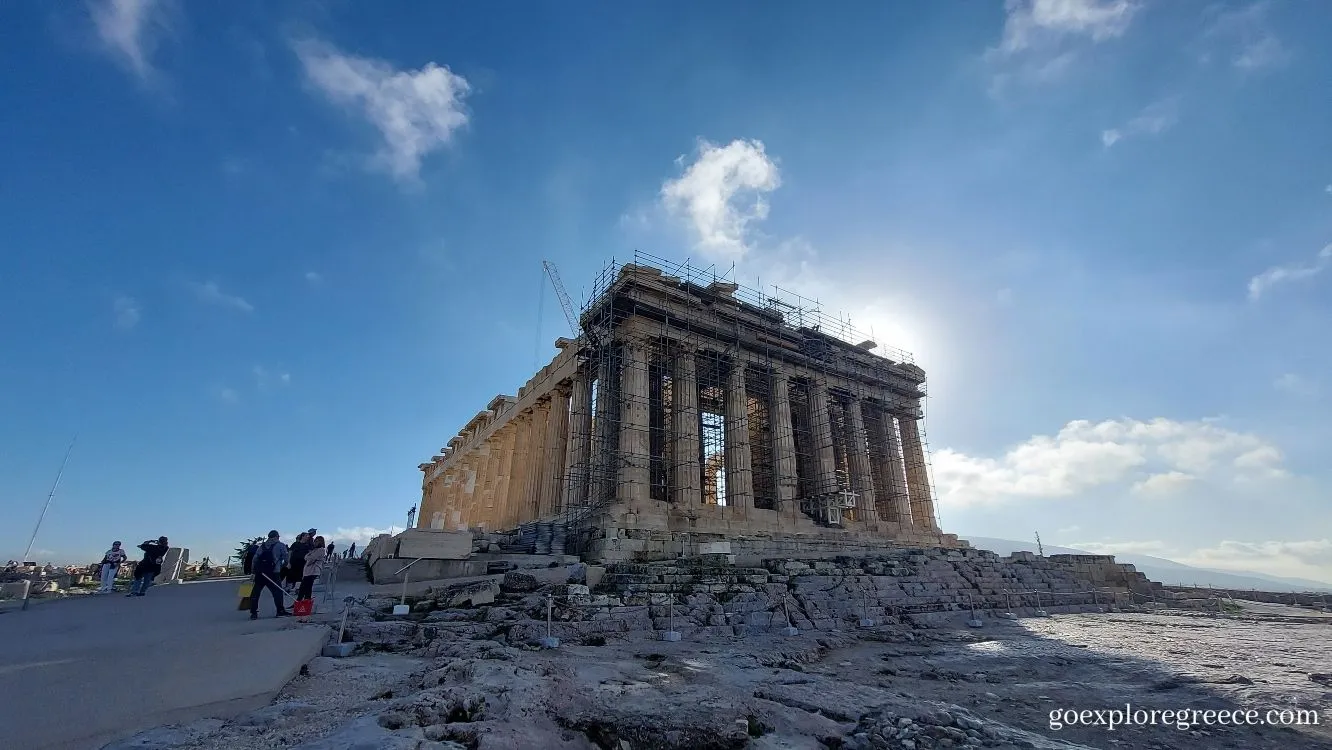

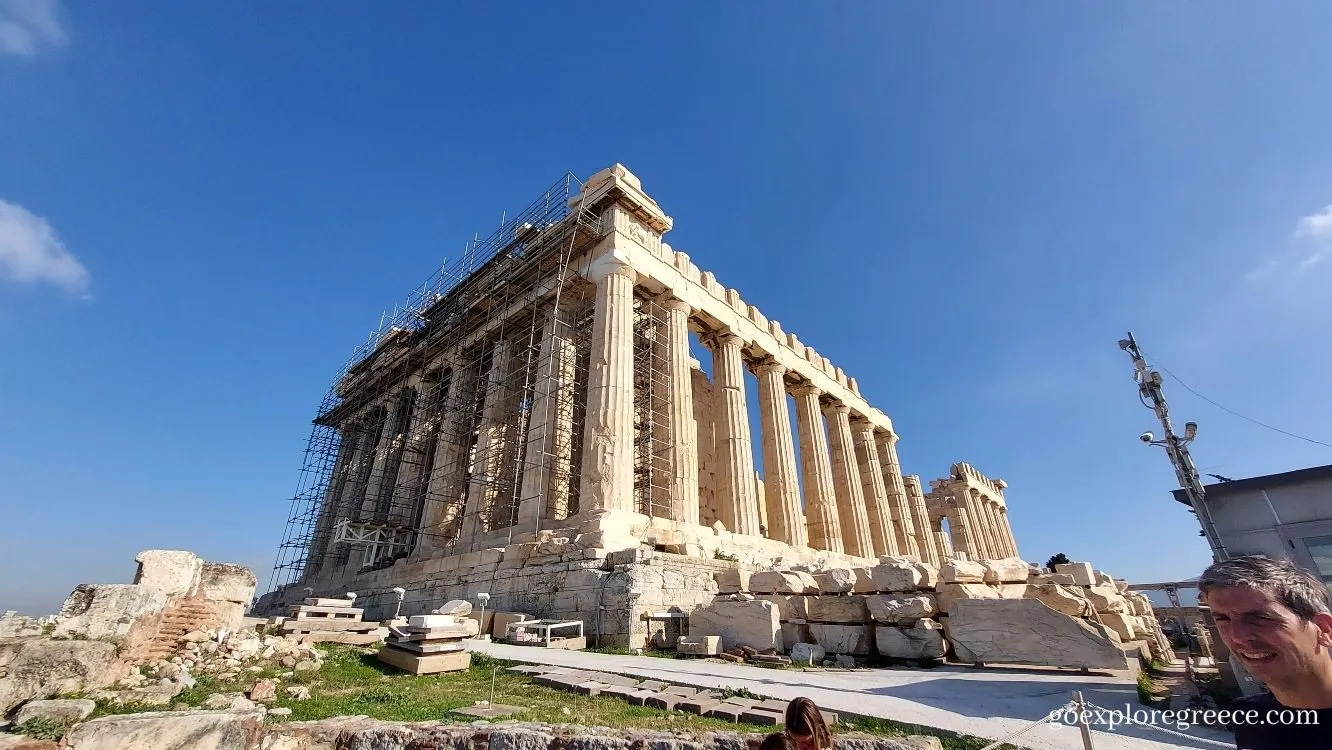





Access for Those With Disabilities and Impairments
Thanks to the Greek Government, from the beginning of 2021, visitors with mobility issues now have access to the Athens Acropolis thanks to a new lift and specially designed paths facilitating wheelchair access.
The modern lift, which replaces a repeatedly malfunctioning one, is located on the north face of the Acropolis along the ancient promenade and will transport wheelchair users and individuals with Disabilities and Impairments to the top of the hill.
The specially designed and renovated 500-meter-long and four-meter-wide pathways also provide access to and around the Parthenon.
2. Temple of Hephaestus
Best for being the best well-preserved ancient site in Athens
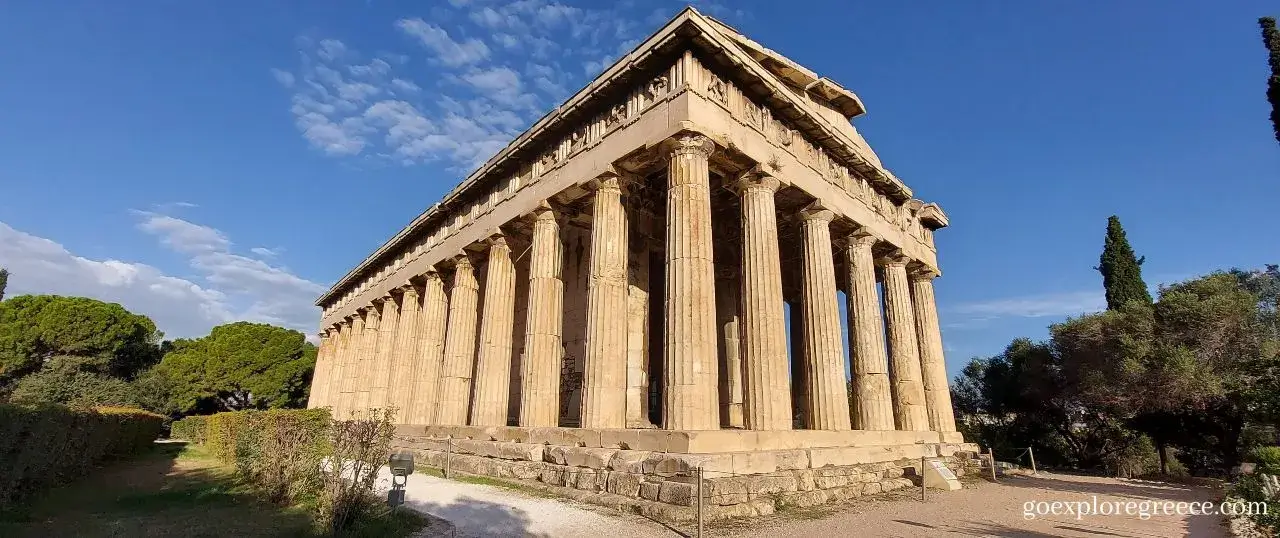
About the Temple of Hephaestus
Number two on the list of the best ancient sites to visit in Athens is the Temple of Hephaestus or Hephaisteion. Formerly called in error the Theseion or Theseum, it is the best-preserved ancient temple globally, and one of the top things to do in Athens.
This magnificent Greek temple stands on the top of the low hill of Agoras Kolonos in Athens, and it is just northwest of the famous Ancient Agora of Athens.
It is particularly special to visit the temple first thing in the morning as it looks stunning and stands as a testament to the sophisticated world of the Ancient Greeks.
Hephaestus was the patron god of metal-working, fire and craftsmanship. During the time there were many potters’ workshops and metal-working shops situated around the temple.
Archaeological evidence suggests that there was no earlier building on the site except for a small sanctuary burned during the Second Persian invasion of Greece in 480 BC.
When Pericles came to power in 461 BC, he came up with a plan to transform Athens into a centre of Greek influence and culture.
In 449 BC, construction began and took around thirty years to complete as funds and workers were directed to building the Parthenon. The western side was completed between 445 BC and 440 BC. During that time, the statue of Athena Hephaistia had been added to the shrine next to the cult statue of Hephaestus.
The temple is built of marble from Mount Penteli, the same marble used to make the Parthenon. The temple dimensions are 13.71 m (45 ft) by 31.78 m, with six columns on the short sides and thirteen columns along the longer north and south sides.
Around 700 AD, the temple was turned into a Christian church dedicated to Saint George.
The Temple of Hephaestus is an excellent place to visit to learn more about ancient Greek architecture. It is also close to many popular attractions, including the Acropolis, the Roman Forum of Athens, and Monastiraki Square. I always enjoy visiting and genuinely consider it to be one of the best ancient sites to visit in Athens.
Best Things to do and See
Look for the many square-carved plaques just below the roof, which go all the way around.
- Then ten on the east side depict the labours of Hercules
- Four show the labours of Theseus
- Some show the battle and fall of troy
- Enjoy the spectacular views from standing at the front of the Temple of Hephaestus of the Acropolis of Athens, the Parthenon, the Ancient Agora of Athens, and the surrounding areas.
Best Places for Photos, Videos, and the Perfect Instagram
- As you are walking up the hill towards the temple, there are several opportunities to get some spectacular photos.
- From the front steps of the temple, looking up at the columns and pediment.
- From the side, looking down the row of columns.
- Standing with your back to the temple, you have the opportunity to take some fantastic photos of the Ancient Agora of Athens, The Stoa of Attalos, The Acropolis of Athens, and the Parthenon.
- From the back of the temple, framing the building with the Acropolis in the background.
- Inside the temple, looking up at the coffered ceiling.
- In the surrounding park area, with the Temple of Hephaestus in the distance.
- At night, when the temple is illuminated.
- In the rain, with the Temple of Hephaestus reflecting in a puddle.
My Photos of the Temple of Hephaestus

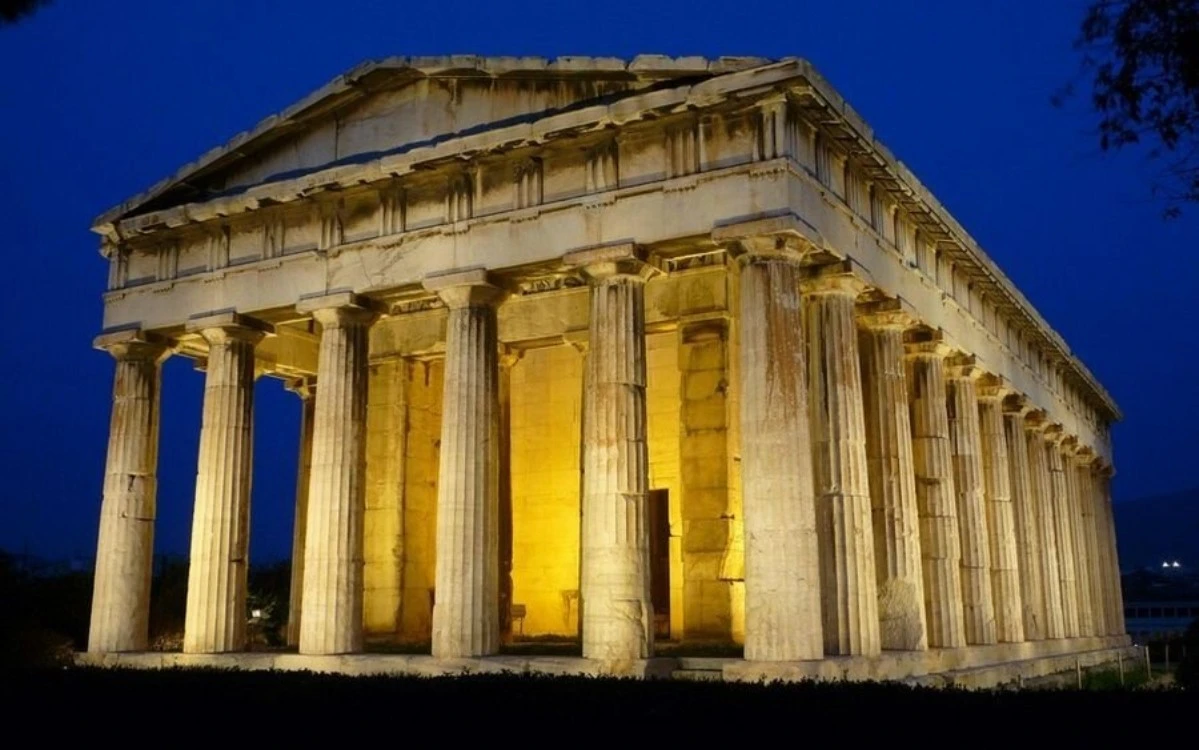






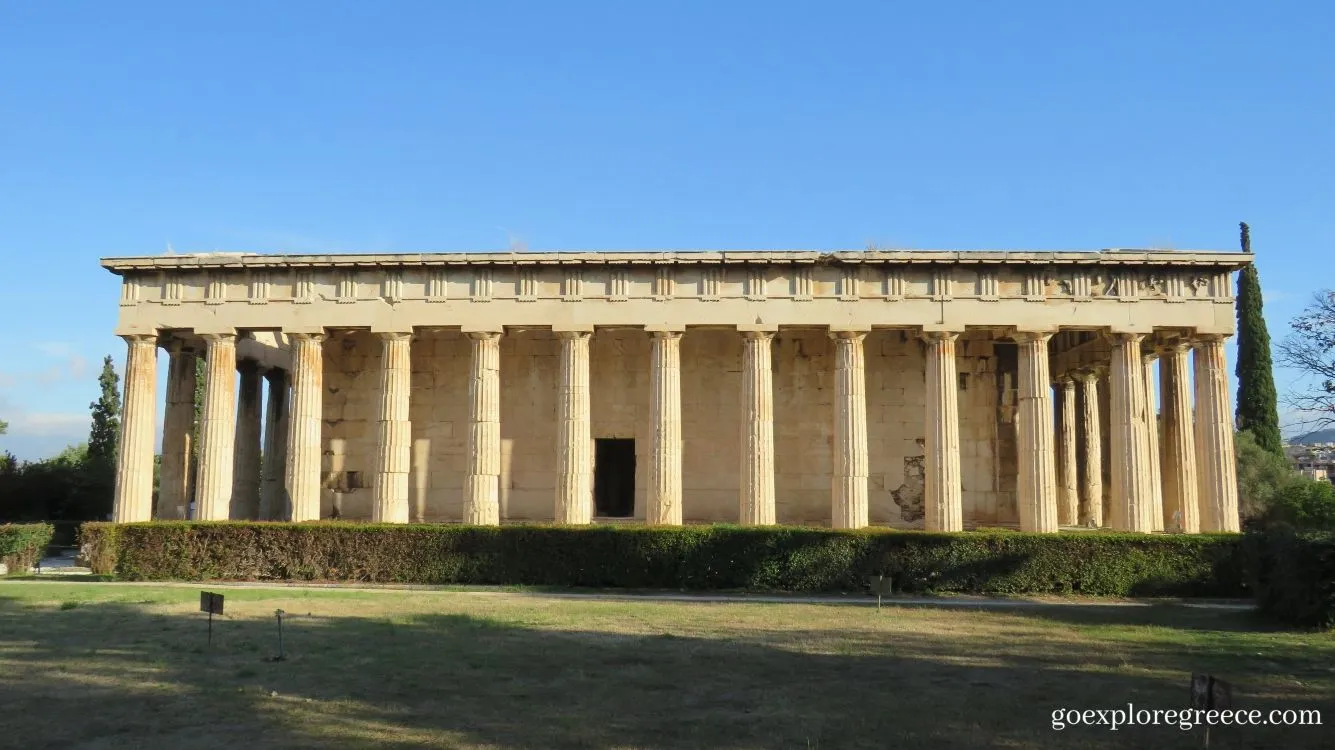

Access for Those with Disabilities and Impairments
In the area of the Temple of Hephaestus, wheelchair access is possible through the entrance at the Thiseion Square (Apostolou Pavlou Street), upon communication (210 3214824, 3210180). You can see the accessible passage in the image at the end.
3. Arch of Hadrian
Best for being completely free and open 24 hours
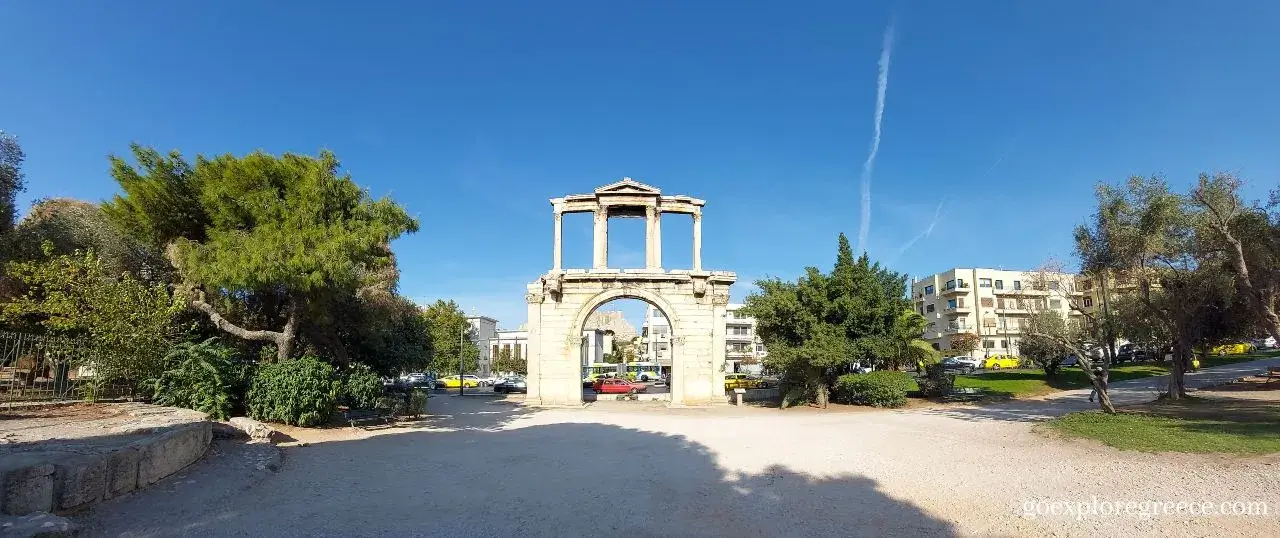
About the Arch of Hadrian
Third on the list of the best ancient sites to visit in Athens is the Arch of Hadrian, also known as Hadrian’s Gate, is one of Athens’s most visited ancient sites after the Acropolis of Athens and the Parthenon.
Some would say, ‘but it’s just an arch isn’t it?’. Why was it built, and why do two inscriptions on opposite sides disagree on whom it’s dedicated. These are just some things still debated today, almost 1900 years later.
Completed in 131-132 A.D., it is not sure who commissioned the arch; however, it was probably the citizens of Athens. There are suggestions it was built to celebrate the arrival of the Roman emperor Hadrian and honour him for his many gifts to Athens. Hadrian had been a citizen of Athens almost 20 years before the arch started construction.
Whilst, it looks like an arch, it’s perhaps a gateway. It spanned an ancient road from the centre of Athens to many structures on the eastern side of the city that still stand today, including the Temple of Olympian Zeus.
It was built from the same (Pentelic) marble as other famous structures in Athens, including the Parthenon and the Tower of the Winds, all transported from Mount Pentelicus mountain northeast of Athens and southwest of Marathon. It was held together using clamps to connect the cut stones during construction. No cement or mortar was used.
The basic dimensions are 18m high, 13.5m wide, and a depth of 2.3m. The design is fully symmetrical from front to back and side to side.
Perhaps the most crucial aspect, and most debated, are the two inscriptions just above the arch’s peak and on opposite sides, naming both Hadrian and Theseus as the founder of Athens.
On the side facing the Acropolis and the Parthenon, the inscription says, ‘This is Athens, the ancient city of Theseus’.
On the side facing the Temple of Olympian Zeus, the inscription says, ‘This is the city of Hadrian, and not of Theseus’.
Recently, it has been suggested that statues of Hadrian and Theseus were positioned on top of the lower level and on either side of the arch.
If you’re looking for top things to do in Athens that are free and open 24 hours, then the Arch of Hadrian is for you.
Best Things to do and See
- The Two Inscriptions
Still debated today after 1900 years, the two inscriptions are carved on the architrave of the arch’s lower level. On the northwest side (towards the Acropolis) the inscription reads:- ΑΙΔ’ ΕΙΣΙΝ ΑΘΗΝΑΙ ΘΗΣΕΩΣ Η ΠΡΙΝ ΠΟΛΙΣ (this is Athens, the ancient city of Theseus.
- The inscription on the southeast side facing the Temple of Olympian Zeus reads
- ΑΙΔ’ ΕΙΣ’ ΑΔΡΙΑΝΟΥ ΚΟΥΧΙ ΘΗΣΕΩΣ ΠΟΛΙΣ (this is the city of Hadrian, and not of Theseus.
- The ancient road it spanned
The arch spanned an ancient road from the centre of Athens to many structures on the eastern side of the city that still stand today, including the Temple of Olympian Zeus. - The marble used to build it
The arch was built from the same (Pentelic) marble as other famous structures in Athens, including the Parthenon and the Tower of the Winds, all transported from Mount Pentelicus mountain northeast of Athens and southwest of Marathon. - Symmetrical design
It is a fully symmetrical design from front to back and side to side. - The architrave
The architrave is the lintel or beam that rests on the columns and supports the roof’s weight. It is decorated with carved reliefs. - Statues of Hadrian and Theseus
It has been suggested that statues of Hadrian and Theseus were positioned on top of the lower level and on either side of the arch.
Best Places for Photos, Videos, and the Perfect Instagram
The best places for photos, videos, selfies, and Perfect Instagram shots are facing towards the arch’s peak, facing the Acropolis and the Parthenon, and facing the Temple of Olympian Zeus.
My Photos of the Arch of Hadrian










Access for Those With Disabilities and Impairments
Access for those with wheelchairs and certain impairments is relatively easy as there is a small path leading to the arch.
Once there, it is easy to move around.
4. Panathenaic Stadium
Best for combining nostalgia and history with an option for a workout

About the Panathenaic Stadium
Fourth on the list of the best ancient sites to visit in Athens is the Panathenaic Stadium (Panathinaikos Stadio, or just Panathineio). It is one of the top things to do in Athens, and it is the only stadium in the world built entirely of marble.
The stadium was initially built as a simple track and field venue by the Athenian statesman Lykourgos. It was rebuilt in marble by the Roman emperor Herodes Atticus in 144 AD after being damaged by an earthquake. It was used for various athletic games, including foot races, boxing, wrestling, discus and javelin throwing.
It is an oval-shaped stadium with a capacity of approximately 45,000 spectators. The long sides of the stadium are 156 m (512 ft) in length, and the short sides are 110 m (360 ft). The stadium is built on a gentle slope, which provides good visibility of the track from all parts of the stadium.
The track of the Panathenaic Stadium is made of marble, which gives it its unique characteristic among all other stadiums in the world. The stadium has fifty-two rows of seats, with twenty-four rows on each long side and four rows on each short side.
The first row of seats on each long side is reserved for the members of the Athens Academy, who are given free tickets to all events held at the stadium.
The Panathenaic Stadium was the venue for the athletics events and the opening and closing ceremonies of the first modern Olympic Games held in Athens in 1896.
It also hosted the athletics events of the 1906 Intercalated Games and the 1999 World Championships in Athletics.
The stadium is still used for athletics competitions, such as the Athens Classic Marathon, held every year in November. It is also used for various cultural events, such as concerts and political rallies.
In May 2001, the Panathenaic Stadium was the finishing point of a visit by Pope John Paul II. More than 80,000 people had gathered at the stadium to hear the Pope’s address.
It is also the finishing point of the annual Athens Classic Marathon, a running event every year in November. The marathon course starts at the Marathonos Gate, near the town of Marathon, and finishes at the Panathenaic Stadium.
The stadium is also used as a concert venue. It has hosted concerts by some of the world’s most famous musicians, including Elton John, Madonna, Rolling Stones, and U2.
Best Things to do and See
- Take a guided tour
There are plenty of tours available to take you around the stadium and explain its history. This is a great way to learn more about the site and see some of its most essential features up close. - Watch a sporting event
Of course, one of the best things to do at the Panathenaic Stadium is watching a sporting event. The stadium hosts various sports, so there’s sure to be something going on during your visit. - Visit the museum
The Panathenaic Stadium is home to a museum that contains a lot of information about the history of the site and the events that have taken place there. It’s definitely worth visiting if you’re interested in learning more about the stadium and its significance. - Climb to the top
If you’re feeling adventurous, you can actually climb to the top of the Panathenaic Stadium for some great views of Athens. Just be sure to wear comfortable shoes and bring plenty of water. - Take a walk around the stadium
Even if you’re not interested in doing any other activities on this list, simply walking around the Panathenaic Stadium is a great way to experience it. The stadium is massive, so you’ll definitely get a good workout. - Take a walk over the starting line
This is where the athletes would start their race in ancient times, and it is still used as a starting line today. - Other things to do
Go for a run around the track and in the footsteps of the great and famous athletes. The track of the Panathenaic Stadium is made of marble, which gives it its unique characteristic among all other stadiums in the world. - Take a break in one of the 45,000 seats for spectators. They offer a great view of the track and the surrounding area.
- Take a walk over to the finishing line and imagine yourself competing with the greats.
- Go and stand on the podium. It is where the race winners would be crowned in ancient times, and it is still used today.
Best Places for Photos, Videos, and the Perfect Instagram
- The starting line
This is where the athletes would start their race in ancient times, and it is still used as a starting line today. It makes for a great photo opportunity, especially with the beautiful backdrop of the stadium. - The track
The track is still in use today and is one of the most popular places to take photos at the Panathenaic Stadium. It is a great place to get a photo of the beautiful architecture and the athletes in action. - The seats
The seats are another popular place to take photos at the Panathenaic Stadium. They offer a great view of the track and the surrounding area. - The finish line
The finish line is where the athletes would finish their race in ancient times, and it is still used as a finish line today. It makes for a great photo opportunity, especially with the beautiful backdrop of the stadium. - The podium
The podium is where the race winners would be crowned in ancient times, and it is still used today. It is a great place to get a photo of the winners and the crowd. - The entrance
The entrance to the Panathenaic Stadium is a great place to take photos. It is a great way to get a photo of the beautiful architecture and the people entering the stadium. - The exit
The exit from the Panathenaic Stadium is also a great place to take photos. It is a great way to get a photo of the beautiful architecture and the people leaving the stadium. - From above
The Panathenaic Stadium offers a great view from above. This is a great place to take photos of the whole stadium as well as the surrounding area. - From below
The Panathenaic Stadium also offers a great view from below. This is a great place to take photos of the beautiful architecture and the people in the stadium. - The surroundings
This is an excellent place to take photos of the surrounding area and the people in the stadium.
My Photos of the Panathenaic Stadium







Access for Those With Disabilities and Impairments
The stadium is located in the background of an enormous square with two steps with portable steel ramps in the middle.
There are two more steps at the entrance with a portable steel ramp.
To avoid the ramps, I suggest that you approach the stadium from the left or the right side, where there are no steps.
At the sides, the square is flat, and there are also gates to enter the stadium from the same level.
5. Odeon of Herodes Atticus
Best for concerts and performances

About the Odeon of Herodes Atticus
Fifth on the list of the best ancient sites to visit in Athens and nestling in a rocky hollow on the southwestern side of the Acropolis of Athens is one of the world’s oldest and finest open-air theatres.
The Odeon of Herodes Atticus is much more than a fascinating archaeological site. Just as it was almost 2000 years ago, it is still used today for performances for up to 5,000 spectators.
Such legendary stars as Jean Michel Jarre, Ennio Morricone, Jethro Tull, Dame Margot Fonteyn, Luciano Pavarotti, Diana Ross, and Elton John have enchanted audiences with their performances in the magical setting of the ancient Odeon under the beautiful Athenian night sky.
Constructed in 161 AD, the Roman theatre was funded by a wealthy benefactor of Athens, Herodes Atticus, who wanted it to be a gift to the people of Athens and built in honour of his late wife, Aspasia Annia Rigilla.
As well as steep semi-circular rows of seating, it had a three-story facade built in stone and a roof made from cedar wood brought from Lebanon.
During the Second World War, when the Germans occupied Greece, the Odeon continued to host many concerts performed by the Athens State Orchestra and the newly formed Greek National Opera.
Further restoration work began on Odeon Herodes Atticus during the 1950s. The city funded the work, and a grand opening ceremony was held in 1955. The Odeon became the main venue for the Athens & Epidaurus Festival – and it remains so to this day.
The Odeon measures 87 metres in diameter. The seating is semi-circular of 36 tiered rows made in marble from Mt Hymettor.
The stage is 35 meters wide and made of coloured Pentelic marble. It has a magnificent and distinctive backdrop made in stone with windows overlooking Athens. It is decorated with columns and niches for statues.
The audience stands, and the orchestra (stage) were restored using Pentelic marble in the 1950s. Since then, it has been the main venue of the Athens Festival, which runs from May through October each year, featuring a variety of acclaimed Greek and international performances.
If you looking for one of the best ancient sites to visit in Athens which allows you to walk around during the day, and watch a concert or performance at night, then this place is for you.
Events, Bands, Artists and Concerts that Appeared at the Odeon of Herodes Atticus
1957 – Maria Callas performed at the Odeon as part of the Athens Festival, and in the same year, Edith Hamilton was pronounced an honorary citizen of Athens at ninety years of age.
1962 – Frank Sinatra gave two Benefit concerts for the city of Athens.
1973 – The venue for the Miss Universe 1973 pageant.
1984 – A memorable performance at the Odeon of Herodes Atticus was given by the Greek singer Nana Mouskouri after 20 years of absence.
1991 – Luciano Pavarotti
1993 – Vangelis and later that year Yanni
1996 Sting during his Mercury Falling Tour
1998 – Mikis Theodorakis
2000 – Elton John as part of his Medusa Tour
2004 – Luciano Pavarotti
2008 – Sylvie Guillem performed Boléro in company with the Tokyo Ballet as part of the Athens Festival.
2010 – The tenor Andrea Bocelli held a concert at the Odeon to raise funds for cancer research.
2012 – Mario Frangoulis performed the leading role in Carl Orff’s Carmina Burana
2018 – Sting for two special concerts.
2020 – The first art exhibition was held by Greek artist Dionisis Kavallieratos, entitled ‘Disoriented Dance / Misled Planet’ organised by NEON Organization and the Athens and Epidaurus Festival.
Other artists who have performed at the Odeon of Herodes Atticus
Alicia de Larrocha, Calexico, Cockney Rebel, Dead Can Dance, Diana Ross, Dionysis Savopoulos, Ennio Morricone, Fairuz, Florence and the Machine, Foo Fighters, George Dalaras, Goran Bregovic, Haris Alexiou, Jean Michel Jarre, Jethro Tull, Joaquín Cortés, José Carreras, Karolos Koun, Kathryn Morgan, Leonidas Kavakos, Liza Minnelli, Manos Hatzidakis, Marinella, Maurice Béjart, Mikis Theodorakis, Montserrat Caballé, Nikos Koundouros, Paco de Lucía, Patti Smith, Plácido Domingo, Sivert Høyem, Spiros Evangelatos, Steve Harley (without the usual band, the Bolshoi Ballets, Yann Tiersen, Yannis Markopoulos
Best Things to do and See
- Attend a concert or play at the Odeon of Herodes Atticus.
- Take a tour of the structure.
- Enjoy the views of the Acropolis from the theatre.
- Have a picnic on the grounds of the theatre.
- Relax in the gardens of the theatre.
- Take a walk through the ruins.
- Learn about the history of the structure.
Best Places for Photos, Videos, and the Perfect Instagram
Just before you continue on the path towards the Parthenon, there is a great opportunity to capture the entire theatre, the view of Athens, and the Filopappou Hill.
My Photos of the Odeon of Herodes Atticus










6. Temple of Olympian Zeus
Best for disability and impairment access

About the Temple of Olympian Zeus
Sixth on the list of the best ancient sites to visit in Athens is the Awe-inspiring (even in ruins) the Temple of Olympian Zeus. It is the largest in Greece, exceeding even the Parthenon in size. Also known as the Olympieion or Columns of the Olympian Zeus, it was dedicated to the Olympian Zeus, a name originating from his position as head of the Olympian gods.
Construction began in the 6th century BC during the rule of the Athenian tyrants, who envisaged building the greatest temple in the ancient world. Still, it was not completed until the reign of the Roman Emperor Hadrian in the 2nd century AD, some 638 years after the project had begun.
During the Roman period, the temple, which included 104 colossal columns, was renowned as the largest temple in Greece and housed one of the largest cult statues in the ancient world.
The temple’s glory was short-lived, as it fell into disuse after being pillaged during a barbarian invasion in 267 AD, just about a century after its completion. It was probably never repaired and was reduced to ruins after that.
In the centuries after the fall of the Roman Empire, it was extensively quarried for building materials to supply building projects elsewhere in the city. Despite that, a substantial part of the temple remains today, notably sixteen of the original gigantic columns. It continues to be part of an essential archaeological site in Greece.
Best Things to do and See
If you’re lucky, you might be able to catch a glimpse of the temple while it’s lit up at night.
Another must-see at the temple is the colossal statue of Zeus that stands inside. It’s an impressive sight, and it’s definitely worth a visit.
There are also many other smaller statues and sculptures around the temple complex. These are all worth checking out, and they provide an excellent opportunity to learn about Greek mythology.
Best Places for Photos, Videos, and the Perfect Instagram
In front of the main entrance, to capture the scale and grandeur of the temple.
From inside one of the many columns, for a unique perspective.
In front of the statue of Zeus that once sat atop the temple – now located in the National Archaeological Museum.
At sunset, when the temple is illuminated in the golden hour light.
My Photos of the Temple of Olympian Zeus




Access for Those with Disabilities and Impairments
The Temple of Olympian Zeus is wheelchair accessible throughout.
It has a small wheelchair ramp at the entrance and a 5 m long ramp down (4-star flatness).
This is followed by 2 small wheelchair ramps up to the Temple of Olympian Zeus.
7. Ancient Agora of Athens
Best for exploring, taking your time and just relaxing

About the Ancient Agora of Athens
My final choice on the list of the best ancient sites to visit in Athens is the Ancient Agora of Athens which was the heart of the ancient city and the centre of Athenian democracy. It was the focal point for political, commercial, administrative and social activity, the religious and cultural centre, and the seat of justice.
The most important buildings were centred around the central open space, or Agora, a meeting place for citizens to gather, discuss politics, conduct business or hear speeches. Today, the Ancient Agora is one of Athens’s most popular tourist attractions. Its well-preserved ruins provide a fascinating insight into life in Ancient Greece.
From the 6th century BC, many public buildings gradually surrounded the open space. It was adorned with temples, altars, stoas (covered walkways), fountains, portraits, and statues.
Many famous and well-known people have walked through the Agora and addressed the people, including Socrates and St Paul. Many essential roads ended in the Ancient Agora of Athens, including Piraeus St, which connected the city with the town and port of Piraeus.
There were around 35 buildings, structures and monuments located in the Ancient Agora of Athens, from which I have listed the most popular in the section “Top Things to See and do at the Ancient Agora of Athens”. Here is the list of all those discovered so far.
North Side of the Ancient Agora of Athens
- Stoa Poikile (Painted stoa), a building built in the 4th century BC, used purely for socialising, unlike many other buildings in the Agora.
- Altar of the Twelve Gods.
- Stoa Basileios (Royal stoa).
- Temple of Aphrodite Urania.
- The south end of what is believed to be a Basilica has been uncovered near Hadrian Street and is dated to the mid 100s AD.
East Side of the Ancient Agora of Athens
- The Stoa of Attalos, a stoa lined with shops built in the 2nd century BC, has since been reconstructed for use as the Museum of The Ancient Agora.
- The Peristyle Court was a law court located initially under the northern end of the Stoa of Attalos.
- A collection of buildings were added to the southeast corner: the East stoa, the Library of Pantainos, the Nymphaeum and a temple.
- The Library of Pantainos was more than just a library. The west and north wings were a series of rooms used for other purposes other than storing books. With the construction of the Library of Pantainos, the official entrance into the Agora was now between the Library and the Stoa of Attalos.
- The Mint is a building used for the minting of bronze coinage in the 2nd and 3rd centuries BC. Still, there is no evidence of it being used for the minting of Athenian silver coinage.
- The Monopteros was located south of the Basilica and dated to the mid 100s AD. It had no walls, was a dome supported by columns and was about 8 meters in diameter.
- The Bema was a speakers platform located near the Stoa of Attalos.
South Side of the Ancient Agora of Athens
- The Middle stoa was the most extensive monument built during the 2nd century BC.
- A small Roman temple was added in front of the Middle Stoa.
- South-east Fountain House.
- South Stoa I.
- Aiakeion.
West Side of the Ancient Agora of Athens
- Strategeion
- Agoraios Kolonos
- Tholos
- Boundary stone
- Monument of the Eponymous Heroes, a monument for the ten heroes of the tribes of Athens which, was also used as a notice board for new legislation, public events and military conscription.
- Metroon (Old Bouleuterion)
- Bouleuterion
- Temple of Hephaestus (Hephaestion)
- Temple of Apollo Patroos
- Stoa of Zeus
- The Temple of Zeus Phratrios and Athena Phratria dated to the 300s BCE and is located near the Temple of Apollo Patroos.
- A statue of the Roman emperor Hadrian was located near the metroon.
Other Notable Monuments
- A number of other notable monuments were added to the Agora. Some of these included:
- An Altar of Zeus Agoraios was added to the east of the monument to the Eponymous Heroes.
- The Temple of Ares, dedicated to Ares, the god of war, was added in the north half Agora, just south of the Altar of the Twelve Gods.
- The Odeon of Agrippa and accompanying gymnasium were added to the centre of the Agora.
- There is evidence of a Synagogue in the Agora of Athens in the 3rd century.
If you want to get a feel for what life was like in Ancient Greece, then the Ancient Agora of Athens is definitely worth a visit.
Best Things to do and See
Stoa of Attalos
The Stoa of Attalos is one of the most impressive buildings in the Ancient Agora of Athens. It was built by and named after King Attalos II of Pergamon, who ruled between 159 BC and 138 BC.
It is thought to have been a kind of ancient commercial centre with up to 22 shops and stalls on each of the two floors lining the western wall. The truly impressive dimensions are 115 metres (377 feet) by 20 metres wide (65 feet ) and made from the same marble as the Parthenon is.
In the early 1950s, the Stoa of Attalos was fully reconstructed on the original foundations using the original materials found on-site by the American School of Classical Studies at Athens.
Temple of Hephaestus
The Temple of Hephaestus in Athens is the best-preserved ancient temple in the world.
This magnificent Greek temple stands on the top of the low hill of Agoras Kolonos in Athens, and it is just northwest of the famous Ancient Agora.
It is particularly special to visit the temple first thing in the morning as it looks stunning and stands as a testament to the sophisticated world of the Ancient Greeks.
The temple is so well preserved for centuries because from the 7th century BC until 1834 it was used as a place of worship.
It is dedicated to Hephaestus, the god of fire and metalwork (who made the legendary shield of Achilles) and to Athena, the goddess of pottery and crafts. Interestingly, archaeologists discovered the remains of many small pottery and metal workshops surrounding the temple.
Work began constructing the temple in 445 BC when Pericles was in power, and he was keen to make Athens the focus of Greek culture. The temple was designed by the architect, Iktinus, and was not completed for 30 years, as both Iktinus and the funding were temporarily diverted to the construction of the Parthenon.
Altar of the Twelve Gods
The Altar of the Twelve Gods (also called the Sanctuary of the Twelve Gods) was an important altar and sanctuary at the Ancient Agora of Athens. It was established by Pisistratus the Younger (the grandson of the tyrant Pisistratus) around 521 BC. It marked the central point from which distances from Athens were measured and was a place of supplication and refuge.
The exact identities of the twelve gods to whom the Altar was dedicated are uncertain. Still, they were most likely substantially the same as the twelve Olympian gods represented on the east frieze of the Parthenon: Aphrodite, Apollo, Ares, Artemis, Athena, Demeter, Dionysus Hephaestus, Hera, Hermes, Poseidon, and of course Zeus.
Museum of the Ancient Agora of Athens
The Museum of the Ancient Agora of Athens is located inside the Stoa of Attalos, and most of the well-preserved collections are about Athenian democracy.
The collections include bronze, clay and glass objects, coins, sculptures, and inscriptions from the 7th to the 5th century BC and pottery of the Byzantine period and the Turkish occupation. The exhibition within the museum contains a work of art that describes the private and public life in ancient Athens.
In 2012, a fascinating and extensive sculpture exhibition was added to the museum, including items from the excavation at the Ancient Agora of Athens.
The Monument of the Eponymous Heroes
Situated near the Metroon (An ancient Greek temple dedicated to a mother goddess) is the Monument of the Eponymous Heroes. It was a marble podium that bore the bronze statues of the ten heroes representing the tribes of Athens.
It was a centre of information and used to post items of importance to all Athenians, including, proposed legislation, decrees and announcements.
Best Places for Photos, Videos, and the Perfect Instagram
The Ancient Agora of Athens is a photographer’s dream, with its stunning ancient architecture set against the backdrop of the Acropolis. There are many beautiful places to take photographs at the Ancient Agora, but some of our favourites include:
Stoa of Attalos
Capturing the entire left side with the front shows the impressive size and the columns.
Temple of Hephaestus
Looking up towards the temple from the base of the low hill of Agoras Kolonos.
Standing at the front to capture the size and beauty.
In the small grass area to the left to capture the length and the columns.
Lots of opportunities to photograph the amazing views of the entire Ancient Agora of Athens, and the surrounding area.
Lots of places to photograph the Acropolis of Athens and the Parthenon.
Altar of the Twelve Gods
In from the Altar of the Twelve Gods and to the side to include buildings.
Museum of the Ancient Agora of Athens
There are many opportunities to take photos of some fantastic artefacts, objects and art.
The Monument of the Eponymous Heroes
Capturing the length and side of this monument is always a great choice.
My Photos of the Ancient Agora of Athens




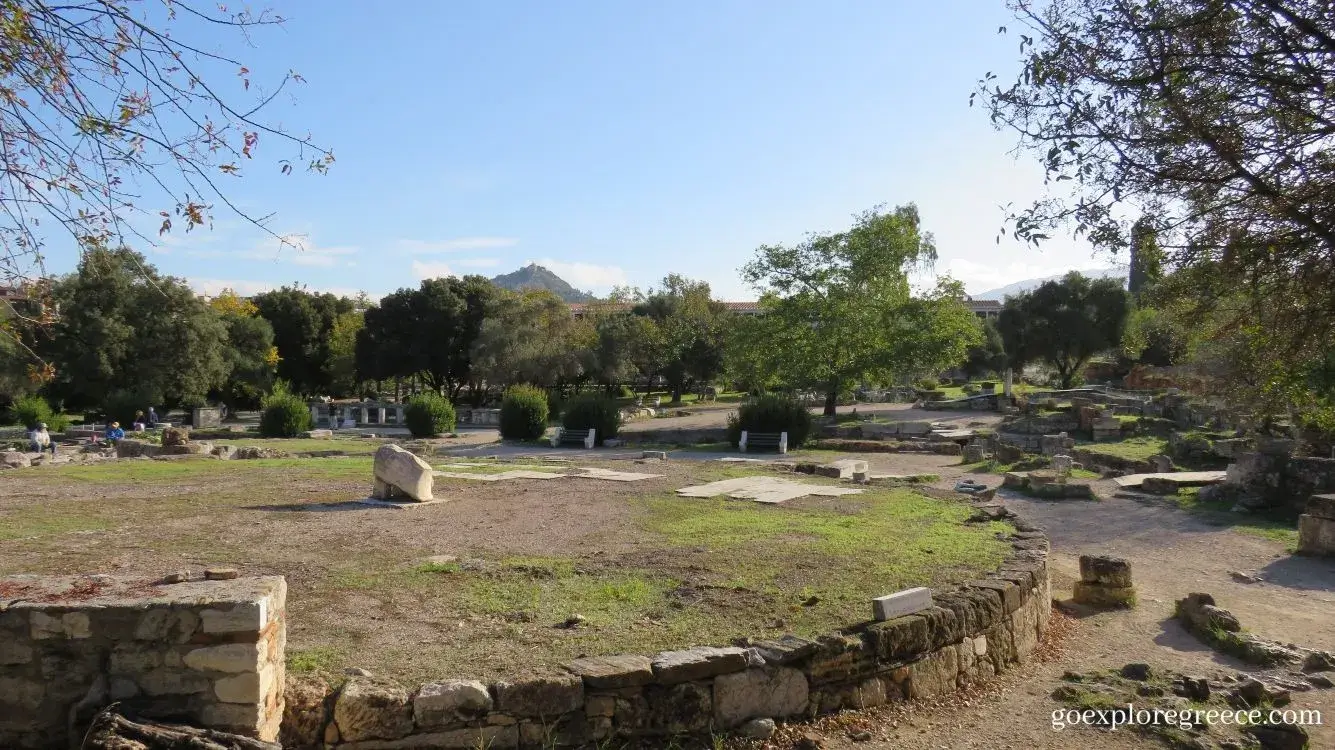





Access for Those with Disabilities and Impairments
The Archaeological Site of the Ancient Agora of Athens is wheelchair accessible through the main entrance, at Adrianou 24 (assistance by a companion is advisable).
In the area of the Temple of Hephaestus, wheelchair access is possible through the entrance at the Thiseion Square (Apostolou Pavlou Street), upon communication (210 3214824, 3210180). You can see the accessible passage in the image at the end.
Both levels of the Museum of the Ancient Agora at the Stoa of Attalos are wheelchair accessible. To access the upper floor using the lift visitors are encouraged to ask the guards. There are also toilets for individuals with disabilities within the building.
At the Museum of the Ancient Agora (Stoa Attalou – Information desk), tactile site plans and brochures in Braille in Greek and English are available for visually impaired visitors.
In Closing
Deciding which ancient sites to see in Athens will always be down to several factors, including how much time you have, how busy they are, and of course, your interests.
My choice of the top 7 best ancient sites to visit in Athens will not be to everyone’s liking. It is also likely it will change, and this is the beauty of Athens: there’s always something new around the corner.
I regularly post photos on my social pages, including Instagram. You’re more than welcome to pop over and follow.
Thank you for reading this blog, and I hope you got what you needed.

